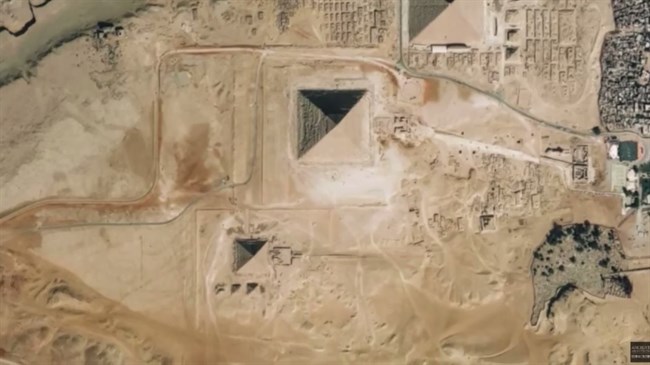Egypt breakthrough: ‘Lost fourth Pyramid of Giza FOUND’ after the remarkable discovery
The Great Pyramid of Giza, the Khafre pyramid and the Menkaure pyramid build on the outskirts of Cairo, all of which are constructed during the Fourth Dynasty of the Old Kingdom.
But the fourth pyramid once stood on the west of the Menkaure Pyramid, which was later destroyed to build the Cairo city according to Frederik Ludvig Nord’s account, in 1737.
Nearly 300 years later Sibson revisited the definition to see if there could be hard evidence to share the findings of his “Ancient Architects” YouTube channel.
He said: “Using Norden’s own words, looking at the topography of the land and also drawing on my research from the past couple of years, I believe I have found the location for where the lost, fourth pyramid of Giza once stood.
“Looking at satellite photos of Giza, we are looking for an area slightly west of the main rough diagonal axis, an area beyond the Pyramid of Menkaure.
“I used to think the pyramid may well have sat in the rectangular enclosure to the west of the Menkaure pyramid, but this doesn’t really work as it doesn’t match Norden’s words.
“Looking at his map, we can instantly see that it isn’t to scale or accurate when comparing it to a satellite photo, but it does give us a rough estimate of how the pyramids were laid out and the fourth pyramid certainly isn’t due west of the Menkaure pyramid.
“This sketch by Norden, looking towards the southwest also shows that the fourth pyramid is on the diagonal and again is not due west of the Menkaure pyramid.
“So the obvious place for the pyramid to be is in the space outside the Menkaure enclosure and the rectangular enclosure as well.” But Sibson then made a breakthrough in his research, matching the location with what he believes to be an ancient causeway.
He added: “This would put the missing pyramid slightly due west of the rough axis of the three main pyramids on what looks to be some flat prepared ground.
“You may say that this is just guesswork, but then I remembered the Wall of the Crow, a 650-feet-long and 32-foot-high wall located to the south of the Sphinx. “It displays truly incredible stonework, with enormous blocks of stone used in its construction.
“Experts date it to the Fourth Dynasty, but I and many others suspect it actually predates the pyramids, making it one of the oldest pieces of architecture in the Giza Plateau.
“Nobody knows why it was built, but I suspect it was an old causeway, leading from where the River Nile used to be, up to the Giza Plateau, just like the three other pyramids.
“The Wall of the Crow, if extended, leads to nothing of note, but that would only be true if you are unaware of Norden’s description of a lost fourth pyramid.” Each of the three pyramids of Giza has a long causeway leading to where the River Nile once extended. Sibson’s description appears to reveal a fourth, leading to the suspected location of another pyramid.
He added: “What I’ve discovered is the Wall of the Crow would lead directly to this small patch of land that I’ve already identified as the best possible location for the fourth pyramid based on the topography and Norden’s description.
“Interestingly, it also perfectly aligns with Khufu and Khafre’s pyramids.
“I think it is certainly possible, but what happened to it? Well, some authors have suggested that it was dismantled in the 1700s, and the stone used for building the nearby city of Cairo.
“According to research, there is evidence of a pyramid being dismantled in 1759 and took 10 months.
“This pyramid would have been quite different from the others, around 100 feet smaller than the others and apparently had a cube on top, which I would guess was for a statue.” Most experts tend to dismiss the notion of a fourth pyramid, suggesting Nordon mistook one of the so-called “satellite” pyramids of Menakure as a fourth Pyramid. But, this contradicts his account, which describes the pyramid as entirely different from the others.
In his book “Voyage d’Egypte et de Nubie” (Travels in Egypt and Nubia), Norden describes the mysterious pyramid as being made of “stone more black than the common granite.” Interestingly, the description and illustrations of Norden are of superb quality, and they position the fourth, black pyramid at some distance from the three Pyramids of Giza. He also accounts for seven, possibly eight, smaller pyramids in the Giza Plateau.
